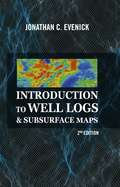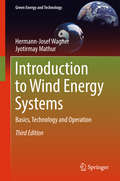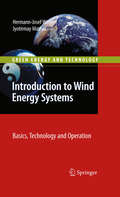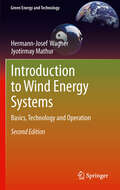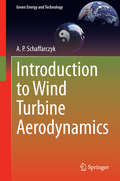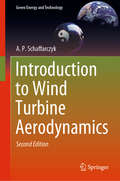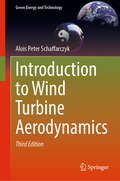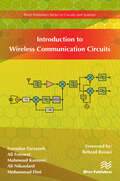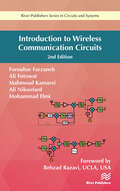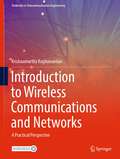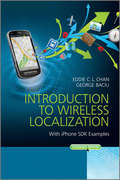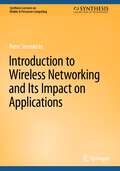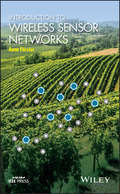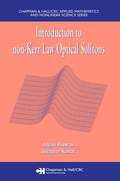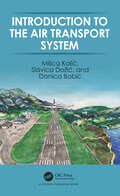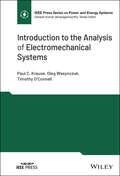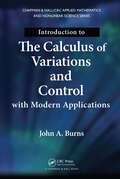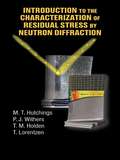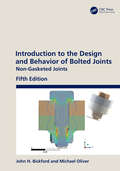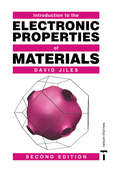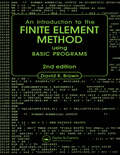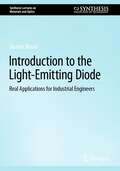- Table View
- List View
Introduction to Well Logs & Subsurface Maps, 2nd Edition
by Jonathan C. EvenickSubsurface mapping is a way to visualize and spatially characterize subsurface properties, and well logs are often the dataset used to generate and calibrate these maps. The correlation of basic geophysical logs rapidly enables oneself to begin to illustrate and understand the one-dimensional to 3D distribution of various properties. The second edition of Dr. Jonathan Evenick's book covers many types of basic well logs and subsurface maps. This book will help you quickly understand what many of these well logs are measuring and how they can be used to produce various subsurface maps. Three additional chapters and exercises have been included on spectral gamma ray logs, fault seal, geothermal energy, and source rock maps (unconventional resources). Features and Benefits Introduction to basic well logs and subsurface maps Applied exercises at that the end of each chapter Additional topics and materials have been included (i.e., spectral gamma ray logs, unconventional resources, geothermal maps, fault seal, paleogeographic maps, and resource uncertainty). Well log and subsurface mapping exercises for use in subsurface mapping, well logging, petroleum, hydrogeology, mining, and geothermal energy courses. *Full answer key available by request. Audience Geologists Geophysicists Petroleum and reservoir engineers Hydrogeologists Environmental consultants
Introduction to Wind Energy Systems
by Hermann-Josef Wagner Jyotirmay MathurThe present book was written to address the needs of those readers interested in wind energy converters. The authors have tried to strike a balance between a short book chapter and a very detailed book for experts in the field. There were three prime reasons behind doing so: first, the field is highly interdisciplinary and requires a more accessible format for non-experts. The second reason for this more compact version is that both authors have encountered many students and technically oriented people who were searching for this type of book on wind energy. The third reason and motivation for writing this book was to provide some initial information to people who are embarking on a career in the wind industry. It is this group of people that the present book is targeted at.
Introduction to Wind Energy Systems: Basics, Technology and Operation
by Hermann-Josef Wagner Jyotirmay MathurAuthors have tried to strike a balance between a short book chapter and a very detailed book for subject experts. There were three prime reasons behind doing so: first, the field is quite interdisciplinary and requires simplified presentation for a person from non-parent discipline. Second reason for this short-version of a full book is that both the authors have seen students and technically oriented people, searching for this type of book on wind energy. Third reason and motivation was considering engineers who are starting their career in wind industry. This book is targeted to present a good starting background to such professionals.
Introduction to Wind Energy Systems: Basics, Technology and Operation, 2nd Edition
by Hermann-Josef Wagner Jyotirmay MathurThe present book was written to address the needs of those readers interested in wind energy converters. The authors have tried to strike a balance between a short book chapter and a very detailed book for experts in the field. There were three prime reasons behind doing so: first, the field is highly interdisciplinary and requires a more accessible format for non-experts. The second reason for this more compact version is that both authors have encountered many students and technically oriented people who were searching for this type of book on wind energy. The third reason and motivation for writing this book was to provide some initial information to people who are embarking on a career in the wind industry. It is this group of people that the present book is targeted at.
Introduction to Wind Turbine Aerodynamics
by A. P. SchaffarczykWind-Turbine Aerodynamics is a self-contained textbook which shows how to come from the basics of fluid mechanics to modern wind turbine blade design. It presents a fundamentals of fluid dynamics and inflow conditions, and gives a extensive introduction into theories describing the aerodynamics of wind turbines. After introducing experiments the book applies the knowledge to explore the impact on blade design. The book is an introduction for professionals and students of very varying levels.
Introduction to Wind Turbine Aerodynamics (Green Energy and Technology)
by A. P. SchaffarczykThis book offers an introduction to the topic for professionals and students with a diverse range of backgrounds. Wind Turbine Aerodynamics is a self-contained textbook that shows how to progress from the basics of fluid mechanics to modern wind turbine blade design. It presents the fundamentals of fluid dynamics and inflow conditions, as well as extensive information on theories describing the aerodynamics of wind turbines. After examining a number of related experiments, the book applies the lessons learned to blade design. The text of the 2nd edition has been thoroughly revised, with a focus on improved readability. The examples and solutions have been extended to explain each problem in much greater detail.
Introduction to Wind Turbine Aerodynamics (Green Energy and Technology)
by Alois Peter SchaffarczykThis book is an introduction to wind turbine aerodynamics for professionals and students with a diverse range of backgrounds. It is a self-contained textbook that shows how to progress from the basics of fluid mechanics to modern wind turbine blade design. It presents the fundamentals of fluid dynamics and inflow conditions, as well as extensive information on theories describing the aerodynamics of wind turbines. After examining a number of related experiments, the book applies the lessons learned to blade design.The text of this 3rd edition has been thoroughly revised, and the book includes a new section on aerodynamic design and optimization.
Introduction to Wireless Communication Circuits
by Forouhar Farzaneh Ali Fotowat Mahmoud KamareiOver the past decade, tremendous development of Wireless Communications has changed human life and engineering. Considerable advancement has been made in design and architecture of related RF and microwave circuits. Introduction to Wireless Communication Circuits focusses on special circuits dedicated to the RF level of wireless communications. From oscillators to modulation and demodulation, and from mixers to RF and power amplifier circuits, all are presented in a sequential manner. A wealth of analytical relations is provided in the text alongside various worked out examples. Related problem sets are given at the end of each chapter. Basic concepts of RF Analog Circuit Design are developed in the book.
Introduction to Wireless Communication Circuits (River Publishers Series In Circuits And Systems Is A Series Of Comprehensive Academic And Professional Books Which Focus On Theory And Applications Of Circuit And Systems. This Includes Analog And Digital Integrated Circuits, Memory Technologies, System-on-chip And Processor Design. The Series Also Includes Books On Electronic Design Automation And Design Methodology, As Well As Computer Aided Des)
by Forouhar Farzaneh Ali Fotowat Mahmoud Kamarei Ali Nikoofard Mohammad ElmiOver the past decade the tremendous development of Wireless Communications has changed human life incredibly. Considerable advancement has been made in the design and architecture of communications related RF and Microwave circuits. This book is focused on special circuits dedicated to the RF level of wireless Communications. From Oscillators to Modulation and Demodulation and from Mixers to RF and Power Amplifier Circuits, the topics are presented in a sequential manner. A wealth of analysis is provided in the text alongside various worked out examples. Related problem sets are given at the end of each chapter.
Introduction to Wireless Communications and Networks: A Practical Perspective (Textbooks in Telecommunication Engineering)
by Krishnamurthy RaghunandanThis book provides an intuitive and accessible introduction to the fundamentals of wireless communications and their tremendous impact on nearly every aspect of our lives. The author starts with basic information on physics and mathematics and then expands on it, helping readers understand fundamental concepts of RF systems and how they are designed. Covering diverse topics in wireless communication systems, including cellular and personal devices, satellite and space communication networks, telecommunication regulation, standardization and safety, the book combines theory and practice using problems from industry, and includes examples of day-to-day work in the field. It is divided into two parts – basic (fundamentals) and advanced (elected topics). Drawing on the author’s extensive training and industry experience in standards, public safety and regulations, the book includes information on what checks and balances are used by wireless engineers around the globe and address questions concerning safety, reliability and long-term operation. A full suite of classroom information is included.
Introduction to Wireless Localization: With iPhone SDK Examples (Wiley - IEEE)
by George Baciu Eddie C. ChanThis book provides a comprehensive overview of the entire landscape of both outdoor and indoor wireless positioning, and guides the reader step by step in the implementation of wireless positioning applications on the iPhone. Explanations of fundamental positioning techniques are given throughout the text, along with many programming examples, providing the reader with an independent, practical, and enjoyable learning of the material while gaining a real feel for the subject. Provides an accessible introduction to positioning technologies such as Global Positioning System and Wi-Fi positioning Presents hands-on skills to iOS 5.0 programming for location-aware applications Gives a thorough grounding in signal propagation, line-of-sight and interference effects for accurate positioning Covers the location-aware video streaming and conferencing with practical iPhone application examples Accompanied by a website containing programming code described in the text and lecture presentation slides for instructors This book is primarily intended for anyone who wants to study wireless localization. It is an ideal textbook for graduate students who are first learning localization techniques, as well as advanced undergraduates in computer science interested in translating localization concepts into real code. Professionals, engineers and researchers working in location-aware services and related techniques using mobile positioning and AI technologies will find this book to be a helpful reference. Companion website for the book: www.wiley.com/go/chan/wireless
Introduction to Wireless Networking and Its Impact on Applications (Synthesis Lectures on Mobile & Pervasive Computing)
by Peter SteenkisteThis book teaches readers how wireless networks work, why some of their properties impact wireless network performance at the application level, and what both network engineers and application developers can do to cope with these challenges. Internet users increasingly rely on wireless access links for diverse tasks such as web browsing, video conferencing, interactive games, and data sharing. Irrespective of how they access the Internet, they expect good performance and a high quality of experience. Unfortunately, wireless access networks are much more challenging to build than wired networks. In wired networks, signals used for communication are contained in a carefully engineered transmission medium. In contrast, wireless signals travel in our physical environment, where the presence of obstacles, interference, and mobility can affect communication. In addition, network performance can differ significantly across physical environments. As a result, the performance of wireless links is often lower and less predictable than that of wired links. The author structured the book according to the layers in the Internet protocol stack, similar to traditional network books. However, rather than presenting a general description of each layer, the focus is on wireless networks and how they differ from wired networks.
Introduction to Wireless Sensor Networks
by Anna FörsterExplores real-world wireless sensor network development, deployment, and applications Presents state-of-the-art protocols and algorithms Includes end-of-chapter summaries, exercises, and references For students, there are hardware overviews, reading links, programming examples, and tests available at [website] For Instructors, there are PowerPoint slides and solutions available at [website]
Introduction to non-Kerr Law Optical Solitons
by Anjan Biswas Swapan KonarDespite remarkable developments in the field, a detailed treatment of non-Kerr law media has not been published. Introduction to non-Kerr Law Optical Solitons is the first book devoted exclusively to optical soliton propagation in media that possesses non-Kerr law nonlinearities.After an introduction to the basic features of fiber-optic com
Introduction to the Air Transport System
by Milica Kalić Slavica Dožić Danica BabićThe book provides deep insights into the operations and business of the air transport system, i.e., airlines, airports, and ATC/ATM (Air Traffic Control/Management). It reviews activities of the air transport operators, functions and processes, as well as the needs and requirements of users and customers in a simple and easy to understand way. A brief description of aviation history, the air transport system development and processes are followed by the elaboration of the aircraft’s elements, masses, payload-range diagrams, and balance. The fundamentals of airports and the ATC/ATM service providers and their contribution to the air transport system are also provided. Moreover, the most important elements in the airport and ATC/ATM system are examined, and the rules, regulations and simplified approaches to how these systems operate are described. The airlines play an important role in the air transport system as users of the airports’ and ATC/ATM service providers. Different business models are presented as well as the fundamentals of airline planning, operations and management (including passenger demand, market segmentation, scheduling, tariffs, alliances, and frequent flyer programs). Besides passenger transport, the book contains an overview and comprehensive guide of the air cargo transport by addressing the key issues such as: the current trends, market characteristics, unit load devices, cargo handling, air cargo documents, and transport of different kind of goods (perishable, live human organs, live animals, dangerous, heavy, etc.).
Introduction to the Analysis of Electromechanical Systems (IEEE Press Series on Power and Energy Systems)
by Oleg Wasynczuk Paul C. Krause Timothy O'ConnellDiscover the analytical foundations of electric machine, power electronics, electric drives, and electric power systems In Introduction to the Analysis of Electromechanical Systems, an accomplished team of engineers delivers an accessible and robust analysis of fundamental topics in electrical systems and electrical machine modeling oriented to their control with power converters. The book begins with an introduction to the electromagnetic variables in rotatory and stationary reference frames before moving onto descriptions of electric machines. The authors discuss direct current, round-rotor permanent-magnet alternating current, and induction machines, as well as brushless direct current and induction motor drives. Synchronous generators and various other aspects of electric power system engineering are covered as well, showing readers how to describe the behavior of electromagnetic variables and how to approach their control with modern power converters. Introduction to the Analysis of Electromechanical Systems presents analysis techniques at an introductory level and at sufficient detail to be useful as a prerequisite for higher level courses. It also offers supplementary materials in the form of online animations and videos to illustrate the concepts contained within. Readers will also enjoy: A thorough introduction to basic system analysis, including phasor analysis, power calculations, elementary magnetic circuits, stationary coupled circuits, and two- and three-phase systems Comprehensive explorations of the basics of electric machine analysis and power electronics, including switching-circuit fundamentals, conversion, and electromagnetic force and torque Practical discussions of power systems, including three-phase transformer connections, synchronous generators, reactive power and power factor correction, and discussions of transient stability Perfect for researchers and industry professionals in the area of power and electric drives, Introduction to the Analysis of Electromechanical Systems will also earn its place in the libraries of senior undergraduate and graduate students and professors in these fields.
Introduction to the Calculus of Variations and Control with Modern Applications
by John A. BurnsIntroduction to the Calculus of Variations and Control with Modern Applications provides the fundamental background required to develop rigorous necessary conditions that are the starting points for theoretical and numerical approaches to modern variational calculus and control problems. The book also presents some classical sufficient conditions a
Introduction to the Characterization of Residual Stress by Neutron Diffraction
by M.T. Hutchings P.J. Withers T.M. Holden Torben LorentzenOver the past 25 years the field of neutron diffraction for residual stress characterization has grown tremendously, and has matured from the stage of trial demonstrations to provide a practical tool with widespread applications in materials science and engineering. While the literature on the subject has grown commensurately, it has also remained
Introduction to the Design and Behavior of Bolted Joints: Non-Gasketed Joints
by Michael Oliver John H. BickfordThe fully updated Fifth Edition of John H. Bickford's classic work, updated by Michael Oliver, provides a practical, detailed guide for the design threaded bolted joints, the tightening of threaded joints, and the latest design procedures for long-term life. New sections on materials, threads, and their strength have been added, and coverage of FEA for design analysis is now included. Referencing the latest standards, this new edition combines fastener materials, explanation of how fasteners are made, and how fasteners fit together, supplementing the basic design coverage included in previous versions of this authoritative text. Introduction to the Design and Behavior of Bolted Joints: Non-Gasketed Joints will be of interest to engineers involved in the design and testing of bolted joints.
Introduction to the Electronic Properties of Materials
by David C. JilesElectronic materials provide the basis for many high tech industries that have changed rapidly in recent years. In this fully revised and updated second edition, the author discusses the range of available materials and their technological applications.Introduction to the Electronic Properties of Materials, 2nd Edition presents the principles of the behavior of electrons in materials and develops a basic understanding with minimal technical detail. Broadly based, it touches on all of the key issues in the field and offers a multidisciplinary approach spanning physics, electrical engineering, and materials science. It provides an understanding of the behavior of electrons within materials, how electrons determine the magnetic thermal, optical and electrical properties of materials, and how electronic properties are controlled for use in technological applications. Although some mathematics is essential in this area, the mathematics that is used is easy to follow and kept to an appropriate level for the reader.An excellent introductory text for undergraduate students, this book is a broad introduction to the topic and provides a careful balance of information that will be appropriate for physicists, materials scientists, and electrical engineers.
Introduction to the Finite Element Method using BASIC Programs
by D.K. BrownThis updated, revised and extended edition gives a comprehensive introduction to the understanding and use of the finite element method as applied to structures. The text methodically covers all the important bridges in understanding up to and including the introduction of isoparametric elements.
Introduction to the Light-Emitting Diode: Real Applications for Industrial Engineers (Synthesis Lectures on Materials and Optics)
by Hisashi MasuiThis book covers the industrial aspects of light-emitting diodes (LEDs) for solid-state lighting (SSL). The author targets his approach primarily to industrial engineers, in order to guide them in the LED industry. The coverage is highly-applied and based on author’s 32 years of experience in the LED industry and academia. The book starts by addressing the needs that new engineers encounter in an LED company, e.g., characterization, manufacturing, and applications. Later chapters introduce deeper science for more experienced engineers and academic readers. As a result, this book can benefit LED engineers throughout their career.
Introduction to the Light-Emitting Diode: Real Applications for Industrial Engineers (Synthesis Lectures on Materials and Optics)
by Hisashi MasuiThis book covers the industrial aspects of light-emitting diodes (LEDs) for solid-state lighting (SSL). The author targets his approach primarily to industrial engineers, in order to guide them in the LED industry. The coverage is highly-applied and based on author’s 32 years of experience in the LED industry and academia. The book starts by addressing the needs that new engineers encounter in an LED company, e.g., characterization, manufacturing, and applications. Later chapters introduce deeper science for more experienced engineers and academic readers. As a result, this book can benefit LED engineers throughout their career.
Introduction to the Mathematics of Inversion in Remote Sensing and Indirect Measurements (Developments In Geomathematics Ser. #Volume 3)
by S. TwomeyIn this graduate-level monograph, S. Twomey, a professor of atmospheric sciences, develops the background and fundamental theory of inversion processes used in remote sensing — e.g., atmospheric temperature structure measurements from satellites—starting at an elementary level.The text opens with examples of inversion problems from a variety of disciplines, showing that the same problem—solution of a Fredholm linear integral equation of the first kind — is involved in every instance. A discussion of the reduction of such integral equations to a system of linear algebraic equations follows. Subsequent chapters examine methods for obtaining stable solutions at the expense of introducing constraints in the solution, the derivation of other inversion procedures, and the detailed analysis of the information content of indirect measurements. Each chapter begins with a discussion that outlines problems and questions to be covered, and a helpful Appendix includes suggestions for further reading.
Introduction to the Mathematics of Operations Research with Mathematica®
by Kevin J. HastingsThe breadth of information about operations research and the overwhelming size of previous sources on the subject make it a difficult topic for non-specialists to grasp. Fortunately, Introduction to the Mathematics of Operations Research with Mathematica®, Second Edition delivers a concise analysis that benefits professionals in operations research and related fields in statistics, management, applied mathematics, and finance.The second edition retains the character of the earlier version, while incorporating developments in the sphere of operations research, technology, and mathematics pedagogy. Covering the topics crucial to applied mathematics, it examines graph theory, linear programming, stochastic processes, and dynamic programming. This self-contained text includes an accompanying electronic version and a package of useful commands. The electronic version is in the form of Mathematica notebooks, enabling you to devise, edit, and execute/reexecute commands, increasing your level of comprehension and problem-solving.Mathematica sharpens the impact of this book by allowing you to conveniently carry out graph algorithms, experiment with large powers of adjacency matrices in order to check the path counting theorem and Markov chains, construct feasible regions of linear programming problems, and use the "dictionary" method to solve these problems. You can also create simulators for Markov chains, Poisson processes, and Brownian motions in Mathematica, increasing your understanding of the defining conditions of these processes. Among many other benefits, Mathematica also promotes recursive solutions for problems related to first passage times and absorption probabilities.
